| Srl | Item |
| 1 |
ID:
052952
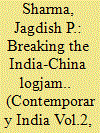

|
|
|
|
|
| Publication |
Oct-Dec 2003.
|
|
|
|
|
|
|
|
|
|
|
|
|
|
|
|
| 2 |
ID:
163480
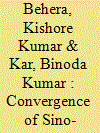

|
|
|
|
|
| Summary/Abstract |
Normalizing relations with China will free vast amount of resources that India is devoting to military build-up and deployment of its forces along Sino-Indian borders. It can also facilitate resolving problems and normalizing relations with Pakistan. Until now, India has been relying heavily, without commensurate benefits, on the US to resolve its problems with Pakistan.
|
|
|
|
|
|
|
|
|
|
|
|
|
|
|
|
| 3 |
ID:
129065
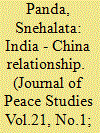

|
|
|
|
|
| Publication |
2014.
|
| Summary/Abstract |
Strong commercial ties moving in tandem with threats and competition epitomize China's relation with India. The end of the cold war added a new dimension to their relationship because interests of both the countries converged on economic development. Strategies were innovated to promote this objective. But economic relationship has not created an environment of trust to shield their bonding from misperceptions and competition. Ironically the trust deficit is due to antithetical perceptions emerging from the divergence of their interests cloaked in the very process of engagement activated in the 19905. No doubt efforts to strengthen their relationship were set in motion much earlier, yet the reconfiguration of geo politics after the end of the cold war gave it a new twist. It may be divided into three phases; the take off phase followed by a vigorous competitive stage and a slow growth phase. In all these phases the common link is trade detached from outstanding problems. Simultaneously both compete for resources to fuel their growing economies and enhance their influence. In neither case popular opinion gets reflected in the pursuit of foreign policy but, apparently there is difference in popular perceptions and official policy. The nature of the political system in India being more free than China popular opinion gets reflected in the media. Nevertheless the official
position of both the countries is to maintain peace without giving vent to unremitting problems. In the context of geo politics, the divergence and convergence of their interests may be assessed at four levels.
|
|
|
|
|
|
|
|
|
|
|
|
|
|
|
|
| 4 |
ID:
125450
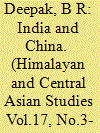

|
|
|
|
|
| Publication |
2013.
|
| Summary/Abstract |
Ever since the formulation of common borders between India and China during the 19th and 20th Centuries, these sailing for Sino-Indian relations has not been smooth. The course of Sino-Indian relationship was filled with the ramps of mistrust, jealousy, hearted and arms conflicts. The territorial aggrandizement of the British and Manchu imperialism turned the peaceful Himalayan region into an area of protracted contest between India and China
|
|
|
|
|
|
|
|
|
|
|
|
|
|
|
|
| 5 |
ID:
135520
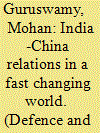

|
|
|
|
|
| Summary/Abstract |
This centaury has been good for India, so far. its economy has been bounding along, finally reflecting a closer correlation between promise and performance. the demographic trends have never been so propitious. Given the current trends and informed forecasts India’s Gross Domestic Product (GDP) is expected to double every seven or eight years. it is climbing closer to $ 2 trillion now. Thus, by, say, 2050, we could be looking at a GDP in real terms of over $ 40 trillion. if the current trends were to do slightly better, and be maintained, by 2050 or even earlier, India could conceivably emerge with the world’s largest GDP.
|
|
|
|
|
|
|
|
|
|
|
|
|
|
|
|
| 6 |
ID:
052947
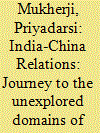

|
|
|
|
|
| Publication |
Oct-Dec 2003.
|
|
|
|
|
|
|
|
|
|
|
|
|
|
|
|
| 7 |
ID:
052954
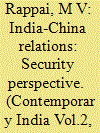

|
|
|
|
|
| Publication |
Oct-Dec 2003.
|
|
|
|
|
|
|
|
|
|
|
|
|
|
|
|
| 8 |
ID:
135523
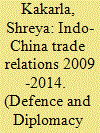

|
|
|
|
|
| Summary/Abstract |
China and India represent two of Asia’s most prominent and powerful societies today. Both these countries have enjoyed relatively high economic growth rates- India with 5.4 percent and Chins with 7.5 percent in 2014. With the rest of the China appear to be emerging as prominent powers in the global market and international affairs.
|
|
|
|
|
|
|
|
|
|
|
|
|
|
|
|
| 9 |
ID:
052961
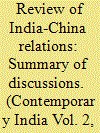

|
|
|
|
|
| Publication |
Oct-Dec 2003.
|
|
|
|
|
|
|
|
|
|
|
|
|
|
|
|
| 10 |
ID:
125369
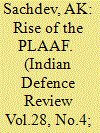

|
|
|
|
|
| Publication |
2013.
|
| Summary/Abstract |
The 'inscrutable' sobriquet for the Chinese is not so much because of their unsmiling faces but on account of their unpredictable actions. Military action against India may not come in the form of a full-fledged war. Small pin pricks in 'disputed territories' may keep increasing in magnitude and frequency until even the submissive and cautious Indian government is constrained to react. Should that happen and a larger military confrontation become inevitable, the PLAAF would be a major instrument of damage to our forces, assets and national pride. Some writings on the 1962 conflict include views that the IAF could have done considerable damage to the Chinese as the PLAAF had outdated aircraft and equipment then. The same is not true about the PLAAF today. The continuing delays in updating capabilities of the IAF relentlessly bring us closer to the possibility of a humiliating experience at the hands of the PLAAF.
|
|
|
|
|
|
|
|
|
|
|
|
|
|
|
|
| 11 |
ID:
052955
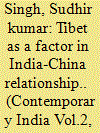

|
|
|
|
|
| Publication |
Oct-Dec 2003.
|
|
|
|
|
|
|
|
|
|
|
|
|
|
|
|
| 12 |
ID:
129382
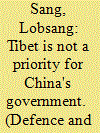

|
|
|
|
|
| Publication |
2012.
|
| Summary/Abstract |
In China don't expect any change even with a new leadership. It is true Xi Jinping's father knew the Dalai Lama and even the Panchen Lama. He had in fact backed China's most liberal premier Hu Yaobang. Whether the father's ideas have influenced the son is not clear. We may or hope to see some change only after the 19th party congress in about five years from now. The present people are in their 60s, people whose minds were shaped in a different era. Also, the system carries on no matter whose in charge. Point to note is that Tibet is not a priority for China's government. How else can you explain Tibet and Tibetans being fed the same medicine even though it's apparent that the medicine is not working.
Immolations have now touched 85. There was one immolation in 2009 but in 2011 it shot up to 23. Match this with the crackdown on Tibetans seeking to enter India through Nepal. The Chinese have sealed close to 75 per cent of the border with Nepal. They have also trained Nepali border guards and are providing food and fuel to Nepali villages near the border to report the presence of any Tibetans in their area. Up to 2008, between 3000-5000 Tibetans used to enter Nepal, now it is down to 1000.
The positive here is that the international community is becoming increasingly vocal about Tibet. After a long time the UN High Commissioner for Human Rights Navi Pillay issued a strong statement on Tibet.
|
|
|
|
|
|
|
|
|
|
|
|
|
|
|
|
| 13 |
ID:
052950
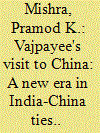

|
|
|
|
|
| Publication |
Oct-Dec 2003.
|
|
|
|
|
|
|
|
|
|
|
|
|
|
|
|
| 14 |
ID:
052951
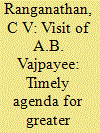

|
|
|
|
|
| Publication |
Oct-Dec 2003.
|
|
|
|
|
|
|
|
|
|
|
|
|
|
|
|